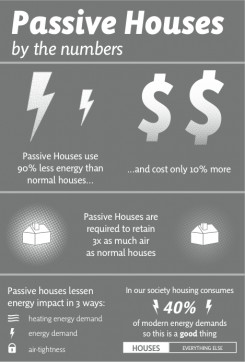The solar panel array that spans the roof of Lyndon Than’s home in North York is an impressive sight. But there’s a lot more to this house than meets the eye.
In 2009, Than and his wife, Phi, started planning to replace their bungalow with a more environmentally-friendly home. They soon stumbled upon the energy efficient Passive House standard. Buildings that adhere to this strict standard use 90 per cent less energy than a typical residence, but cost only about 10 per cent more to build. Than’s new home, which he designed himself, will need to meet strict requirements in three key areas: annual heating energy demand, overall energy demand, and air-tightness. Adhering to these requirements will yield a home that uses less than 15 kilowatt hours per meter squared per year for heating, while a regular house would use around 100 kilowatt hours per meter squared. Similarly, a Passive House cannot leak more than 0.6 times its volume in air per hour, where a typical home may leak more than three times that.
“The standard is very simple [and] elegant, in the sense that if you meet these three [criteria], it’s a Passive House,” Than says.
Achieving the criteria requires the use of special design software, which enables very detailed energy and air flow modeling. “The software looks at the exact dimensions of many parts of the building,” Than explains “The windows, the thickness of the frames, [even] the thermal conductivity of the soil.”
One of the most striking features of Than’s proposed home is the absence of a furnace. Thanks to the house’s air-tightness, it will be warmed via its ventilation system by a heat exchanger that efficiently recycles heat from the air leaving the house by transferring it to air coming in, and then applies additional heat as needed.
Efficient windows that bring in more heat than they let out are also a critical component of a Passive House.
“A lot of houses that are being built today really skimp on the windows,” Than says. “It’s a massive shame because people don’t realize how much heat is being lost through them, and also how much heat is being gained through them if they’re placed in the wrong spot.”
Than explains that large, south-facing, high-quality windows are ideal for minimizing heat gain in the summer and maximizing heat gain in the winter. During the winter, when the sun is low, south-facing windows will bring in extra heat.
Although solar panels are not required in order to obtain Passive House certification, Than notes that there were benefits in incorporating a 50-foot wide array into his designs. For one thing, he estimates that the solar array will generate around 10 megawatt hours per year, which is double what his family will use. For another, the solar panels will essentially be earning their keep. All of the energy that the solar array produces will be sold to the city’s local grid through a government program called microFIT.
The profits that Than earns from microFIT will cover the cost of the solar array in about five years. And while installing solar panels is expensive, Than notes that the cost is actually cheaper now than it has ever been.
“The cost of solar has been plummeting for the last couple of years,” he says. “Four years ago it was 10 dollars a watt; now it’s one dollar a watt.”
In order to share and collaborate with fellow environmental enthusiasts, Than has been blogging about his project since 2010. Than’s home is the first of what he hopes will be many, and he plans to “promote Passive House so that Ontario adopts it at a larger scale.”
Than is particularly adamant about the need to spread the Passive House standards because he believes that action needs to be taken in order to combat the effects of climate change.
“We definitely do need to do something,” he says. “In some circles it would just seem so ridiculous to even say that, because it’s so obvious. But there are still a lot of people who don’t realize that we are in a very dire situation and we need to take action.”
Than notes that buildings consume approximately 40 per cent of modern society’s energy demands, so the do-it-yourself environmentalist’s home is definitely a great place to start.


